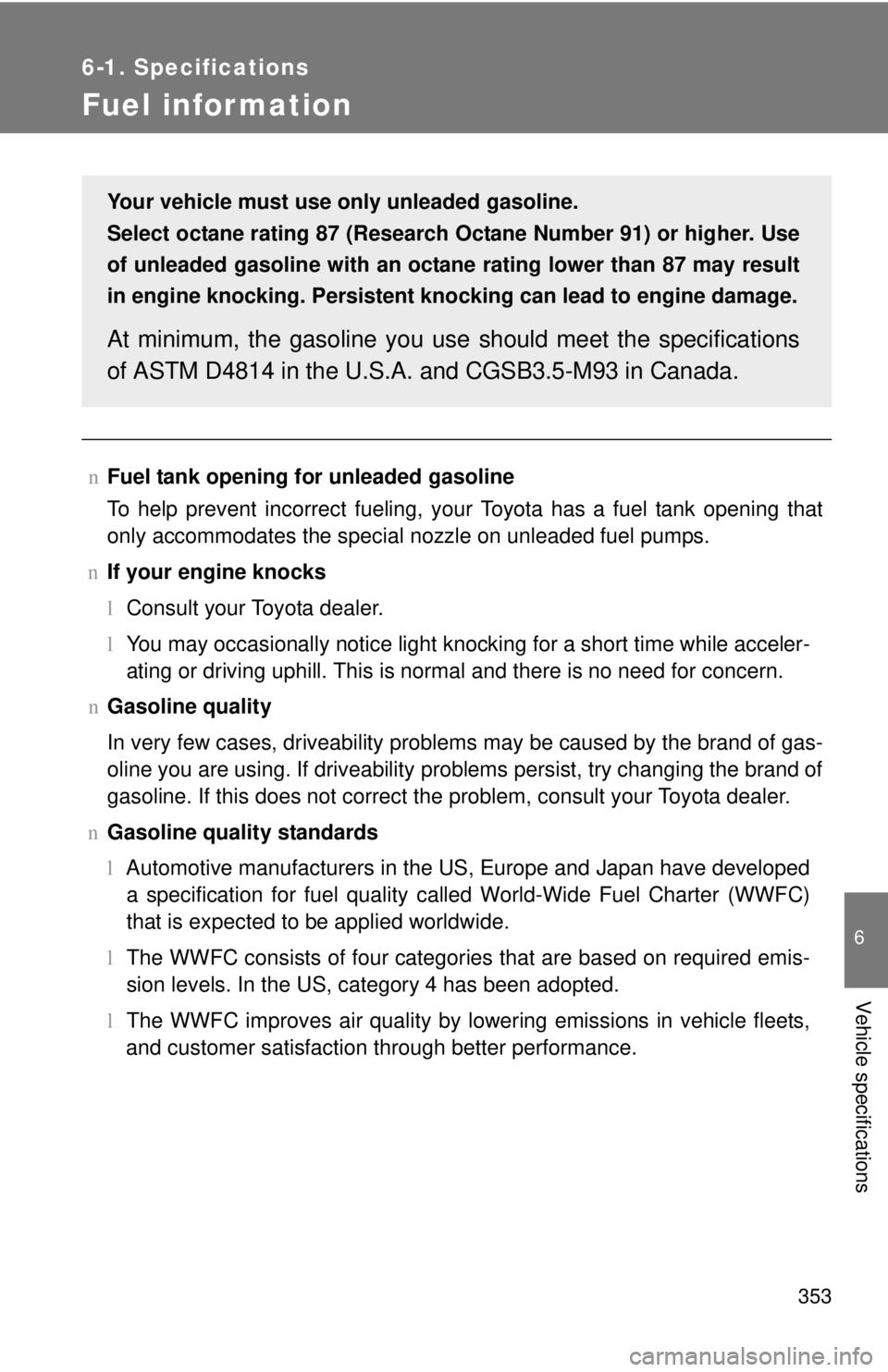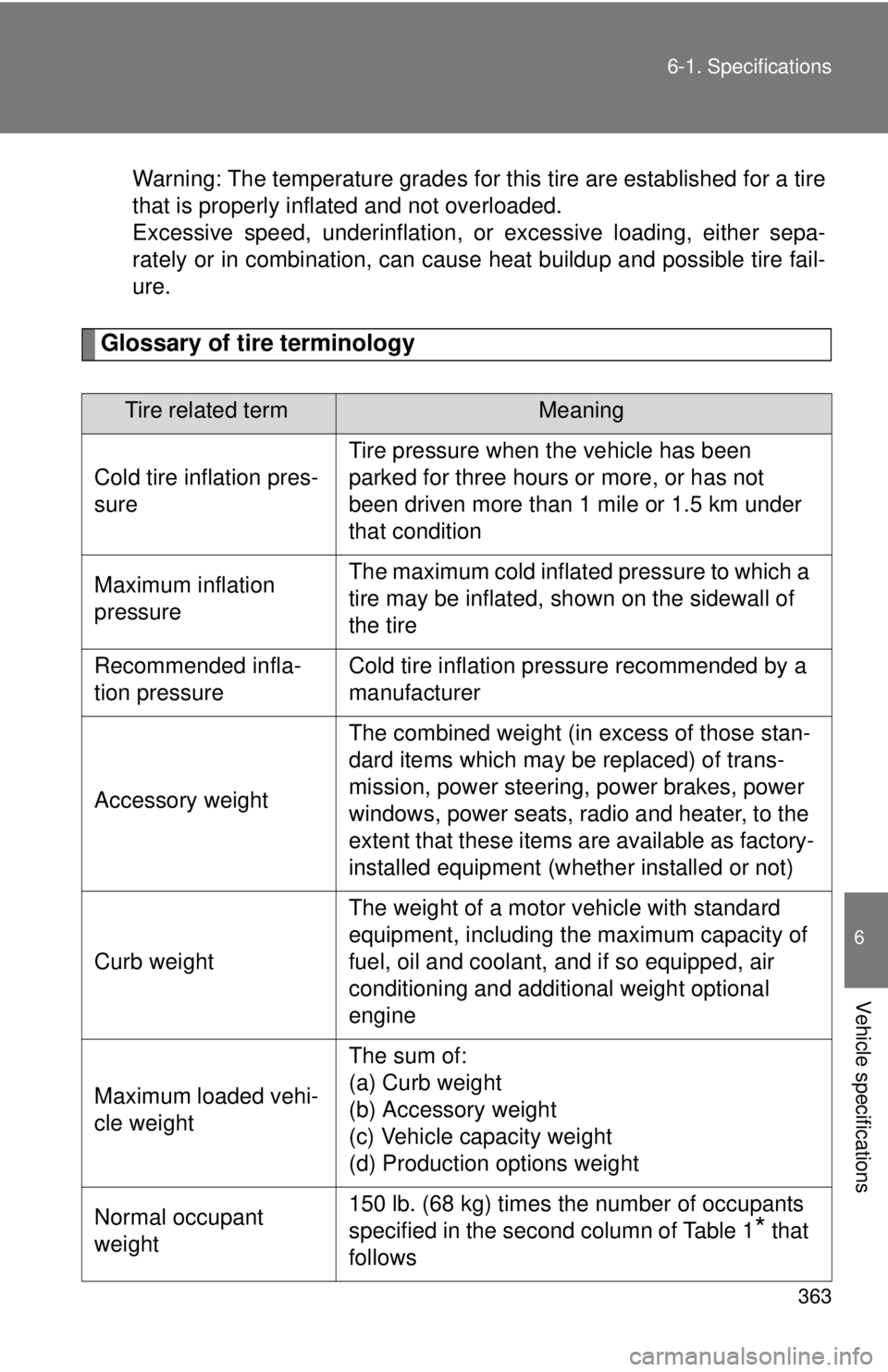Page 359 of 402
350 6-1. Specifications
Clutch
Brakes
*1: Minimum pedal clearance when depressed with the pressure of 67.4 lbf (300 N, 31kgf) with the engine running.
*2: Parking brake adjustment when pulled with the force of 45 lbf (200 N, 20 kgf).
Steering
Clutch free play 0.2 ⎯ 0.6 in. (5 ⎯ 15 mm)
Fluid type FMVSS No.116 DOT 3 or SAE J1703
Pedal clearance *1Vehicles with the ABS
2.9 in. (73 mm) Min.
Vehicles without the ABS
2.8 in. (70 mm) Min.
Pedal free play 0.04 ⎯ 0.24 in. (1 ⎯ 6 mm)
Brake pad wear limit 0.04 in. (1.0 mm)
Brake lining wear limit 0.04 in. (1.0 mm)
Parking brake lever travel *26 — 9 clicks
Fluid typeFMVSS No. 116 DOT 3 or SAE J1703
Free playLess than 1.2 in. (30 mm)
Page 362 of 402

353
6-1. Specifications
6
Vehicle specifications
Fuel information
nFuel tank opening fo r unleaded gasoline
To help prevent incorrect fueling, your Toyota has a fuel tank opening that
only accommodate
s the special nozzle on unleaded fuel pumps.
n If your engine knocks
l Consult your T
oyota dealer.
l Y
ou may occasionally notice light knocking for a short time while acceler -
ating or driving uphill. This is normal and there is no need for concern.
n Gasoline quality
In very few cases, driveability problems may be caused by the brand of gas -
oline you are using. If driveability problems persist, try changing the brand of
gasoline. If this does not correct the problem, c
onsult your Toyota dealer.
n Gasoline quality st
andards
l Automotive manufacture
rs in the US, Europe and Japan have developed
a specification for fuel quality called World-Wide Fuel Charter (WWFC)
that is expected to be applied worldwide.
l The
WWFC consists of four categories that are based on required emis -
sion levels. In the US, category 4 has been adopted.
l The WWFC improves air quality by
lowering emissions in vehicle fleets,
and customer satisfaction through better performance.
Your vehicle must use only unleaded gasoline.
Select octane rating 87 (Research Octane Number 91) or higher. Use
of unleaded gasoline with an octane rating lower than 87 may result
in engine knocking. Persistent kno cking can lead to engine damage.
At minimum, the gasoline you use should meet the specifications
of ASTM D4814 in the U.S.A. and CGSB3.5-M93 in Canada.
Page 363 of 402

354 6-1. Specifications
nToyota recommends the use of gaso line containing detergent additives
l Toyota recommends the use of gasoline that contains detergent additives
to avoid build-up of engine deposits.
l All gasoline sold in the US contains detergent additives to clean and/or
keep clean intake systems.
n Toyota recommends the use of cleaner burning gasoline
Cleaner burning gasoline, including reformulated gasoline that contains oxy-
genates such as ethanol or MTBE (Methyl Tertiary Butyl Ether) is available in
many areas.
Toyota recommends the use of cleaner burning gasoline and appropriately
blended reformulated gasoline. These types of gasoline provide excellent
vehicle performance, reduce vehicle emissions and improve air quality.
n Toyota does not recomm end blended gasoline
l Toyota allows the use of oxygenate blended gasoline where the oxygen-
ate content is up to 10 % ethanol or 15 % MTBE.
l If you use gasohol in your Toyota, be sure that it has an octane rating no
lower than 87.
l Toyota does not recommend the use of gasoline containing methanol.
n Toyota does not recommen d gasoline containing MMT
Some gasoline contains octane enhancing additive called MMT (Methylcy-
clopentadienyl Manganese Tricarbonyl).
Toyota does not recommend the use of gasoline that contains MMT. If fuel
containing MMT is used, your emission control system may be adversely
affected.
The malfunction indicator lamp on the instrument cluster may come on. If
this happens, contact your Toyota dealer for service.
Page 364 of 402
355
6-1. Specifications
6
Vehicle specifications
NOTICE
n
Notice on fuel quality
lDo not use improper fuels. If improper fuels are used the engine will be
damaged.
l Do not use leaded gasoline.
Leaded gasoline can cause damage to your vehicle’s three-way catalytic
converters causing the emission control system to malfunction.
l Do not use gasohol other than that stated here.
Other gasohol may cause fuel system damage or vehicle performance
problems.
l Use of unleaded gasoline with an octane rating lower than 87 may result in
engine knocking. Persistent knocking can lead to engine damage and
should be corrected by refueling with higher octane unleaded gasoline.
n Fuel-related poor driveability
If after using a different type of f uel, poor driveability is encountered (poor
hot starting, vaporization, engine knocking, etc.), discontinue the use of that
type of fuel.
n When refueling with gasohol
Take care not to spill gasohol.
It can damage your vehicle’s paint.
Page 372 of 402

363
6-1. Specifications
6
Vehicle specifications
Warning: The temperature grades for this tire are established for a tire
that is properly inflated and not overloaded.
Excessive speed, underinflation, or excessive
loading, either sepa-
rately or in combination, can caus e hea
t buildup and possible tire fail-
ure.
Glossary of tire terminology
Tire related termMeaning
Cold tire inflation pres-
sure
Tire pressure when the vehicle has been
parked for three hours or more, or has not
been driven more than 1 mile or 1.5 km under
that condition
Maximum inflation
pressureThe maximum cold inflated pressure to which a
tire may be inflated, s hown on the sidewall of
the tire
Recommended infla-
tion pressureCold tire inflation pressure recommended by a
manufacturer
Accessory weight
The combined weight (in excess of those stan-
dard items which may be replaced) of trans-
mission, power steering, power brakes, power
windows, power seats, radio and heater, to the
extent that these items are available as factory-
installed equipment (whether installed or not)
Curb weight
The weight of a motor vehicle with standard
equipment, including the maximum capacity of
fuel, oil and coolant, and if so equipped, air
conditioning and additional weight optional
engine
Maximum loaded vehi-
cle weight
The sum of:
(a) Curb weight
(b) Accessory weight
(c) Vehicle capacity weight
(d) Production options weight
Normal occupant
weight150 lb. (68 kg) times the number of occupants
specified in the second column of Table 1
* that
follows
Page 379 of 402
370 6-2. Customization
Illumination
(
→P. 210) Time elapsed before
lights turn off
15 seconds7.5 seconds
30 seconds
Operation after the
engine switch is turned
to the LOCK position ON OFF
Operation when the
doors are unlocked ON OFF
Seat Belt
Reminder
Buzzer
(
→P. 310) Vehicle speed linked
seat belt reminder
buzzer
ON OFF
Key
Reminder
Buzzer
(
→P. 127) Remind driver to
remove the key
Cycle time
1.2 seconds 0.9 seconds
0.6 seconds
Light
Reminder
Buzzer
(
→P. 146) Remind driver to turn
off the headlights and
others
ON OFF
ItemFunctionDefault settingCustomized
setting
Page 380 of 402
371
6-2. Customization
6
Vehicle specifications
Items to initialize
ItemWhen to initializeReference
Engine oil maintenance
dataAfter changing engine oilP. 249
The following items must be initialized for normal system operation
in cases such as after the battery is reconnected, or maintenance is
performed on the vehicle.
Page 388 of 402

382 Alphabetical index
Child restraint systemBooster seats, definition .......... 98
Booster seats, installation ..... 102
Convertible seats, definition .... 98
Convertible seats,
installation ........................... 102
Front passenger occupant classification system .............93
Infant seat, definition ............... 98
Infant seats, installation......... 102
Installing CRS with LATCH
system ................................ 104
Installing CRS with seat
belts .................................... 105
Installing CRS with top
tether straps ........................ 109
Child safety
Airbag precautions .................. 88
Battery precautions ....... 255, 336
Child restraint system
.............. 98
Child-protectors ....................... 34
How your child should wear
the seat belt ..........................58
Installing child restraints ........ 102
Power window lock switch....... 68
Power window precautions ..... 69
Removed key battery
precautions ......................... 274
Seat belt extender
precautions ...........................61
Seat belt precautions .............. 59
Child-protectors ......................... 34
Cleaning Exterior .................................. 228
Interior ................................... 230
Seat belts .............................. 231
Clock ......................... 135, 137 , 221
Clutch
Fluid ...................................... 350
Pedal .............................. 116,130
Comfort guide ............................ 55
Condenser ................................ 252
CRS ............................................. 98Cruise control
Cruise control ........................ 152
Indicator ................................ 152
Cup holders .............................. 214
Curtain shield airbags ............... 81
Customizable features ............ 369
Daytime running light
system .................................... 146
Defogger
Rear window ......................... 185
Side mirrors........................... 185
Dimension ................................ 344
Do-it-yourself maintenance .... 239
Doors Back door ................................ 36
Door glasses ........................... 67
Door lock ................................. 31
Side doors ............................... 31
Side mirrors............................. 64
Warning light ......................... 310
Driver's seat belt reminder
light ......................................... 310
Driving Break-in tips .......................... 118
Correct posture ....................... 79
Procedures............................ 116
Winter driving tips ................. 161
Electric power steering Electric power steering.......... 155
Warning light .........................
308
Emergency flashers
Switch ................................... 296
Emergency, in case of If the engine will not start ...... 329
If the shift lever cannot be
shifted from P ..................... 331
If the vehicle battery is
discharged .......................... 333
If the warning buzzer
sounds ................................ 307
D
E